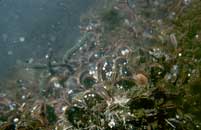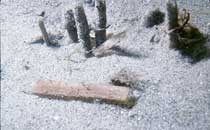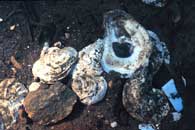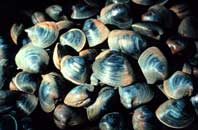4. What types of benthos live in Narragansett Bay?
Organisms living in Narragansett Bay live in different regions of the bay depending upon the location's physical conditions. Changing salinity, currents, depth, and other factors affect where the organism live. Organisms adapt to their community. Although there are some regions where boundaries separate communities, other regions are more integrated without distinct boundaries.
In the Lower Bay temperatures are lower and salinity is higher. Organisms here are well adapted to live in these conditions. In this area beds of sea scallops, ocean quahogs, surf clams, blue mussels, and other marine species are found.

Mussels
(Click for larger image)
The Central Bay has two different communities. In the deep water areas, sediments are soft and salinity is high. Here live deposit-feeding organisms, including small clams and worms. The other area of the central bay has sandy or silt/sand sediments, is at a shallower depth and salinity is also high. Here small tube-dwelling organisms are found and winter flounder flourish. This area is rich in quahogs, Rhode Island's most abundant commercially important species in the bay.

Worm Tubes
(Click for larger image)
A variety of oysters, quahogs, and soft-shelled clams are found in the Upper Bay. The Upper Bay has fluctuating salinity, lower oxygen levels, and is affected by severe water pollution. These conditions have drastically changed this part of the bay and have caused the organisms to move to other regions of the bay. It is hard to monitor an organism's population in this community.

Oysters
(Click for larger image)
Quahogs are the most abundant benthic animal of their size in Narragansett Bay. They are distributed throughout the bay in a wide range of sediments and depths. They are found primarily in mud containing sand, shells and small rocks. They are least abundant in sediments with large percentages of clay. Pollutants in the Bay affect the quahog harvesting because in highly polluted water, quahogs can carry bacteria, causing a range of health problems for humans.

Quahogs
(Click for larger image)
| 


